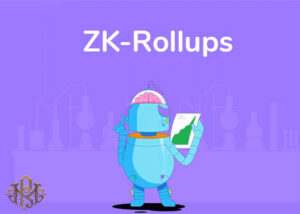
Close



What is zkrollup? Role of zero knowledge roll-up in the scalability of Ethereum Blockchain Ethereum has always faced scalability challenges and is not able to respond to the high volume of users’ demands. This increases the fees on the network and sometimes takes a long time to confirm transactions. But solutions have been provided to solve this problem, and these solutions are generally divided into two categories, internal chain and external chain.
Zero-Knowledge Rollups or zkrollups is a new method to solve Ethereum’s scalability problem, which is created by combining two roll-up and zero-knowledge technologies. This solution uses the combination of a large number of transactions from the first layer network, converting them into a single transaction and sending it to the second layer network. This combination reduces costs and increases the speed of transactions.
Roll-ups combine a large number of transactions from the layer one network into a single transaction. These rollups are managed by smart contracts, however security control is handled by the parent (layer one) network. Also, the off-chain virtual machine is also used to process zero knowledge algorithms.
Zero knowledge rollups are designed as an innovative way to solve Ethereum’s scalability problem. This method uses the combination of two technologies, i.e. roll-up and zero knowledge. Rollup aggregates a large number of transactions from the layer one network and turns them into a single transaction. Then this transaction is sent to the second layer network using smart contracts. This action reduces the total costs and reduces the time of approval of transactions.
Zero knowledge rollups are managed by smart contracts. The main contract in the layer one network is responsible for storing the data blocks created in the second layer (rollup), managing deposits and withdrawals, and tracking the status of transactions. Also, validation contracts are focused on validating proofs that create blocks.

High security: using authentication mechanism in zero-knowledge roll-ups increases network security. Data is stored in layer one to retrieve the status of off-chain transactions.
Fast finalization of transactions: Due to the coordination of layer one with layer two, transactions are finalized quickly and users can quickly transfer their assets between these two networks.
Reduction of costs: data compression reduces the cost of data dissemination from the layer one platform, and as a result, less fees are requested from users.
Complexity: Zero knowledge algorithms are very complex, which makes this technology even more complex. Implementing it requires a large and skilled team.
The need for special virtual machine: Using an off-chain virtual machine with high processing capability requires advanced and expensive hardware, which may reduce the number of operators and centralize network management.
High processing costs: Processing with zero-knowledge algorithms requires high throughput, which may increase processing costs and, as a result, transaction fees.
Solutions based on zero-knowledge rollups have been shown to solve scalability problems, allowing the Ethereum network to handle more than 1,000 transactions per second. Due to the advancements and capabilities of this technology, it is expected that it will find more applications in the future and bring new improvements in the field of scalability and security to the blockchain world.